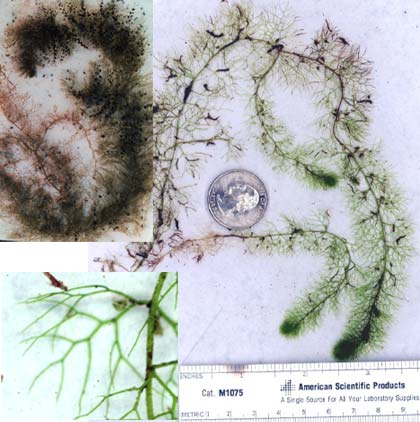Submerged Aquatic Vegetation (SAV) Identification Key
Main_Content
The bay grass key was designed to allow you to identify most species of bay grasses found in Maryland. Although bay grasses are notoriously difficult to identify using standard taxonomic keys, the flexible format of the Internet allows us to combine detailed pictures, simple line drawings and text messages in a stepwise sequence that makes identifying bay grasses simple. You may find it useful to have a clear metric ruler with millimeters marked, a magnifying glass, and a Ziploc plastic bag to help you in the process of identifying your plant.

|
If you already know the identity of a particular bay grass use the drop down boxes below. |
|---|
Common Name:
or
Scientific Name:
| | Common Name: | Bladderwort |
| | Scientific Name: | Utricularia spp. |
| | Native or Non-native: | Native
|
| | Illustration: | 
|
| | Link to larger illustration: |
|
| | Printable Version: | |
| | Family: | Lentibulariaceae |
| | Distribution: | Several species of bladderwort occur in the Chesapeake Bay region, primarily in the quiet freshwater of ponds and ditches but occasionally in the open water of lakes and reservoirs. Bladderworts can also be found on moist soils associated with wetlands. |
| | Recognition: |
Bladderworts are found floating in shallow water or even growing on very moist soils. The stems are generally horizontal and submerged. Leaves are alternate, linear or dissected often appearing opposite or whorled. The branches are often much dissected, appear rootlike and have bladders with bristles around the openings. Bladderworts are considered carnivorous because microscopic animals can be trapped and digested in the bladders that occur on the underwater leaves. When the plant is flowering, it produces flowers with five petals that appear fused together and are often yellow in color. Some species have flowers that come well out of the water and are quite showy. |
| | Ecological Significance: | Even though bladderwort is a carnivorous plant, it can provide habitat and shelter for many macro and micro invertebrates, which in turn provide food for waterfowl and fish. Some of these microorganisms have been found to form symbiotic relationships with the bladderwort plants to help with the attraction and digestion of the plant's prey. |
| | Similar Species: | Coontail (Ceratophyllum demersum) |
| | Reproduction: | Sexual reproduction through many seeds that each plant releases when mature.
|
|
|
Center_Content
For permission to reproduce individual photos, please contact Mike Naylor
The text and photos used in this key were produced through a collaborative effort among the following partners.

